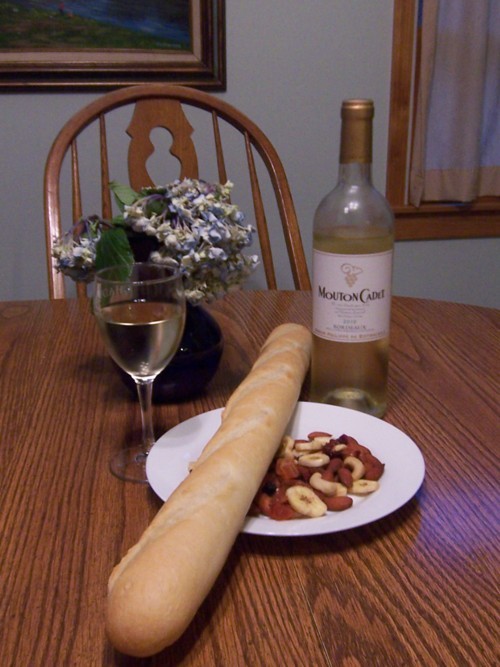Allow me to offer my apologies for not posting last week. My descent from the heights to which I soared on the wings of wine and Wendy’s was Icarus-like. To be dumped unceremoniously into the demented, distorted milieu that I occupy presently nearly broke what is left of my already flimsy resolve. I required an additional week to recover.
Nonetheless, I press on. Well, that is not entirely accurate, as this week’s pairing has been constructed yet again with escapist intentions. The present is horrid and the future bleak, so I look to the past, which is slightly less so. Specifically, I attempt to recapture at least a small portion of my experiences of a year ago, when I spent the month of November in Paris. The electronic artist Little Loud provides a brilliant remix of Memory Tapes’ “Bicycle.” The original song is from the album Seek Magic, an ideal soundtrack for cruising down the grand boulevards on a Vélib'. For refreshment and repast, I have decided upon Mouton Cadet Blanc ($9.99; a 2010 vintage from Bordeaux; a blend of 65% Sauvignon Blanc, 30% Semillon, and 5% Muscadelle), accompanied by a baguette, nuts, and dried fruit (as well as wilted flowers).

This made up the bulk of my daily fare as a traipsed around les bibliothèques et les musées last year. It is a monastically spare, almost coarsely straightforward meal, chosen not only for its economy (eat for 3 euro a day!), but also because, in my opinion, it contrasts amusingly with the sophistication and complexity of the objects and texts I love to examine.
It would, however, be a great injustice to label the Mouton Cadet as spare or coarse. This white, like most French blancs, is a respite from the saccharine vintages I customarily imbibe, which are so delightfully sweet that they may as well be packaged in juice boxes. The Mouton has a steely, firm introduction akin to the powerful first impression made by Michelangelo’s Rebellious Slave, located in a gallery named for the Renaissance master on the ground floor of the Louvre’s Denon wing. The wine’s confident preamble gives way to a subtly calibrated refinement of pear and nectarine notes that somehow rumble quietly, like far-off river rapids, and echo the remarkable illusion of pulsing, rippling undulations in the figure’s marble musculature.

(Michelangelo, Rebellious Slave, 1513-1515; marble; Paris, Musée du Louvre.)
My choice of sustenance also has an evocative purpose. I like to imagine that Michelangelo, famously irascible and neglectful of nearly everything other than his work, may have himself employed such modest morsels to fuel maniacal sessions with the marble.
The opposite end of la Galerie Michel-Ange is occupied by Canova’s masterpiece, Psyche et l’Amour.

(Antonio Canova, Psyche Revived by Cupid's Kiss, 1787-1793; marble; Paris, Musée du Louvre.)
This work is also the polar opposite of Michelangelo’s in regard to a sculpture’s possible impact on its viewer, which was demonstrated to me vividly as I tried to illustrate my written impressions with drawings. When I attempted to sketch the Slave my pen skittered and jumped across the page, but dug in solidly when making contact, depositing quick, energetic, yet assertive lines in its wake. However, when in front of Psyche et l’Amour, despite the most delicate pen strokes I could muster, no line was fine or soft enough; any pressure applied was too heavy. I was compelled eventually to abandon my endeavor, as the work seems to resist tangible apprehension. Canova does not so much enliven dead stone, as Michelangelo does, but performs some sort of mystical alchemy that results in an object that has volume, but no mass; form, but no definitive contours; that is solidly before the viewer at one moment, but dissipates into the ether when caressed by the sun’s rays.

If it is natural to imagine Michelangelo sustaining himself on scraps in his herculean battles with the marble, it is equally easy to envision Canova – a consummate gentleman who was quite at home with the nobility and royalty of Europe – sipping daintily on ambrosia as he effortlessly fashioned this painfully beautiful pair. I remember entering the museum, seeking refuge from the biting November nights, and thawing myself in the presence of Canova’s work, as if it were a smoldering fireplace instead of glacial stone. Similarly, the frigid, flinty wine sluices down my gullet, but results paradoxically in a pleasant warmth that meanders lazily from my core to my extremities. This sensation is a favorite of mine, on par with the simple satisfaction of taking the first bite out of a warm, fresh loaf of bread.
Unfortunately, I do not believe this baguette to be fresh, despite the claims of my local Giant Supermarket. Its warmth is not that of the hearth, but comes from the microwave; a result of my desperate attempt to simulate the sensation mentioned above. Once again, the affliction referred to commonly as reality impinges upon my reveries. However, I must admit that it was nice while it lasted, and what more can one ask than that? Hence, I heartily recommend this pairing and I appreciate your indulgence of my reminiscences.
(Published originally on November 16th, 2011.)
No comments:
Post a Comment